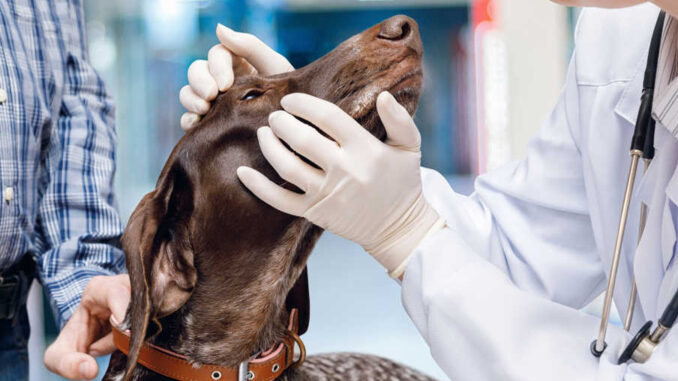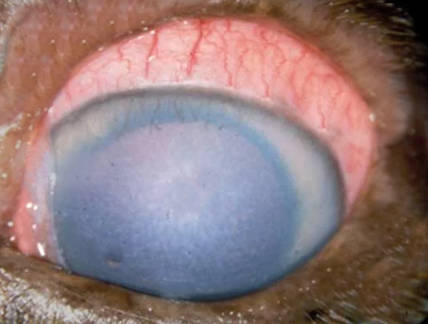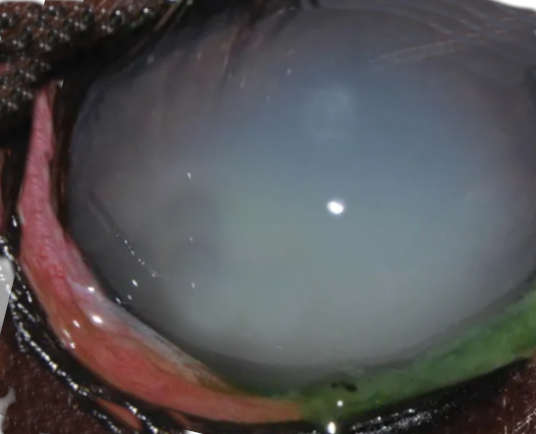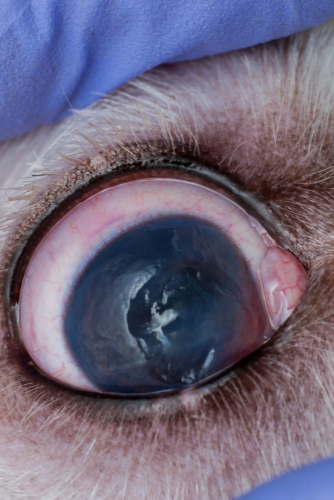
This article was updated on May 2nd, 2023
About the author: Dr. Spiegel is a Veterinarian Ophthalmologist, with 22 years of experience. He earned his doctorate in veterinary medicine in 2001 and is now specialized in eye issues.
My dog’s eye is now red and cloudy. Is it serious?
Many people assume that redness or cloudiness in the eyes is a sign of infection. However, there are many different conditions that can cause these symptoms. In this article, we will explore some of the most common causes of red and cloudy eyes and discuss how to manage them. Fortunately, most causes are treatable.
If you notice your pet’s eyes are red and or cloudy, it is important to seek medical attention as soon as possible. There are many different conditions that can cause a pet’s eyes to become red and or cloudy, so it is important to provide your vet with as much information as possible. By telling the vet about any other symptoms you have noticed, such as excessive tearing or discharge, you can help them diagnose the underlying cause of the problem quickly and accurately.
4 most common causes of red and cloudy eyes in dogs
1. Glaucoma
Below is a picture of a dog eye with acute congestive glaucoma. The image demonstrates a diffuse cloudy eye, dilated pupil, and a red eye:

Glaucoma in dogs is a very serious condition that can cause severe pain and even blindness if left untreated. It is caused by a build-up of pressure inside the eye, which can be caused by a variety of factors, such as injury or disease. Early diagnosis and treatment are essential to prevent long-term damage to the dog’s vision.
There are two main types of glaucoma: primary and secondary. Primary glaucoma is caused by a hereditary defect or an abnormality in the drainage angle of the eye, while secondary glaucoma is caused by another underlying condition.
Glaucoma can develop gradually or very suddenly depending on the cause, it can affect one or both eyes, symptoms often include:
- Very red, cloudy painful eye
- Squinting
- Weepy eyes
- Blindness
- Pupils are wide or unsymmetrical
- Rubbing their eyes or face
- Head shy
- Sensitive to light
- Bulging eyes
Management and outcome of glaucoma: Your dog will need rapid, emergency treatment. Your vet will start treatment with anti-glaucoma medication to bring down the pressure inside your pet’s eyes to ensure they are comfortable and their vision remains healthy. Your vet may recommend referring your pet to an ophthalmologist if medical treatment doesn’t reduce your dog’s symptoms or if the condition requires more specialized care.
Once the condition has been stabilized, it’s important to maintain a regular schedule of medication in order to ensure that your pet’s eye pressure remains within healthy levels.
2. Uveitis:
The picture below shows an eye with acute uveitis. The image demonstrates a diffuse cloudy eye, constricted pupil, and a red eye:

Uveitis is an inflammation of the structures inside the eye, including the iris, ciliary body, and choroid. It can cause changes in the shape, size or colour of the iris. It is important to diagnose and treat uveitis quickly as it can lead to permanent vision loss if left untreated.
Symptoms of anterior uveitis include:
- Red, cloudy painful eye
- Squinting
- Excessive eye discharge
- Change of iris colour or size
- Sensitive to light
- Abnormally shaped pupil
- Possible abnormal vision
Uveitis can have a number of causes such as infection, neoplasia, metabolic, trauma and autoimmune disease. If left untreated it can lead to serious complications such as glaucoma and even blindness. Early diagnosis and treatment are essential for preventing further damage to the eye.
Your vet may run a series of diagnostic tests to narrow down the culprit and rule out any underlying medical conditions. Depending on the cause, treatment could include eye drops, antibiotics or anti-inflammatory.
If your dog is showing any signs of uveitis, it’s important to contact your veterinarian immediately.
3. Dry eye:
Dry eye is a painful condition that can develop in dogs when their tear glands are unable to produce a normal amount of tears. It can cause severe discomfort and pain for dogs, leading to redness, inflammation, and due to lack of tear production, you may see cloudy, dull eyes with a lack of shine.
Dry eye is a common condition that affects the eyes and can cause a range of symptoms such as:
- Thick, sticky discharge
- Redness in and around the eyes
- Cloudy or dull eyes with a lack of shine
- Rubbing their eye or face
- Blinking or closing their eye more than usual
- Eye infections
- Eye ulcers
If left untreated, dry eye can lead to ulcers on the cornea which could lead to vision loss or even blindness. Dry eyes can’t be cured and require lifelong treatment however there are treatments available such as topical eye cream, false tears and in some cases even surgery that can help reduce the symptoms of dry eye and give your pet relief from pain and discomfort.
If your beloved pet is showing signs of dry eye or if you notice any of the symptoms listed above, it’s important to book an appointment with your vet as soon as possible. Early diagnosis and treatment of dry eye can make all the difference for your pet’s comfort and quality of life.
4. Corneal ulcer:
Pictured below is an eye of a dog with a deep corneal ulcer (the eye also appears red and cloudy):

An eye ulcer is a wound on the front of the eye that can cause severe pain and discomfort. These ulcers can develop for a variety of reasons, including trauma to the eye, infection, corneal abrasions, or foreign objects in the eye.
It is important to seek medical attention as soon as possible if an ulcer is suspected in order to prevent further damage and complications. Treatment options vary depending on the cause of the ulcer and may include antibiotics, anti-inflammatory medications, or surgery.
Symptoms are as follows:
- Red, painful and cloudy eye
- Squinting or closed eye
- Blinking more than usual
- Weeping eye
- You may notice an obvious defect on the surface of their eye
- Rubbing their eye or face
- Avoiding bright lights
It is important to seek medical attention as soon as possible if an ulcer is suspected in order to prevent further damage and complications. Treatment options vary depending on the cause of the ulcer and may include antibiotics, anti-inflammatory medications, or surgery. View more pictures of eye ulcers in dogs.
When are red and cloudy eyes in dogs a medical emergency?
It is important to be aware of any changes or abnormalities in your dog’s eyes, as they can indicate a serious problem. If you notice anything wrong with your dog’s eye(s), it is essential that you contact your vet as soon as possible. Your vet will be able to determine the cause of the issue and provide appropriate treatment for your pet. Early detection and prompt treatment are essential for preventing long-term health issues.
Can anything be tried at home before a veterinarian visit?
No, delaying treatment could lead to more severe problems, such as permanent vision loss or even blindness.
What causes red eyes in dogs?
Several other medical conditions can lead to red eyes in dogs:
Conjunctivitis:
Conjunctivitis is an inflammation of the conjunctiva, which is a thin layer of tissue that coats the eyelid and lines the front of the eye. It leads to red, itchy, teary eyes and can be caused by various reasons.
Eyelash problems:
Abnormal eyelashes can cause extreme discomfort and if left untreated, could result in serious vision problems or even scarring. Therefore, it’s important to have your vet check and treat them as soon as possible to prevent further issues.
Eyelid disorders:
Both inward and outward-turning eyelids can often cause discomfort in the form of pain, redness and inflammation.
Masses and tumours:
Red, swollen eyes can often be caused by masses and tumors in a dog’s eye. Therefore, it is important to always keep an eye out for any changes and seek medical advice if necessary.
What causes cloudy eyes in dogs?
Corneal Dystrophy:
Corneal dystrophy is a common inherited condition found in dogs, causing the cornea to become cloudy and opaque. It is divided into three types: epithelial dystrophy, stromal dystrophy, and endothelial dystrophy based on the area of the eye affected.
Although there are treatments available for ulcers and cloudy eyes related to corneal dystrophy, the condition itself is incurable. In some cases, the symptoms of cloudy eyes may stay even after treatment but they usually don’t affect vision significantly.
Disclaimer: This website's content is not a substitute for veterinary care. Always consult with your veterinarian for healthcare decisions. Read More.


Be the first to comment